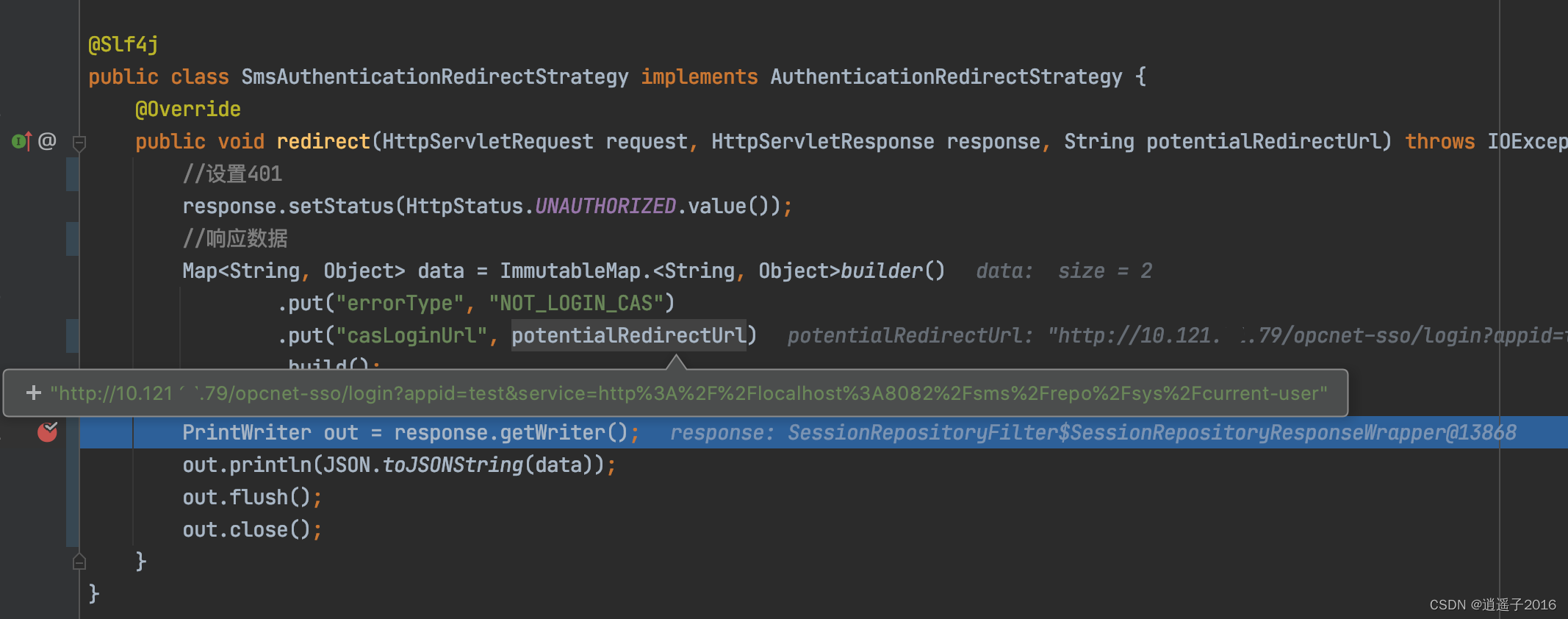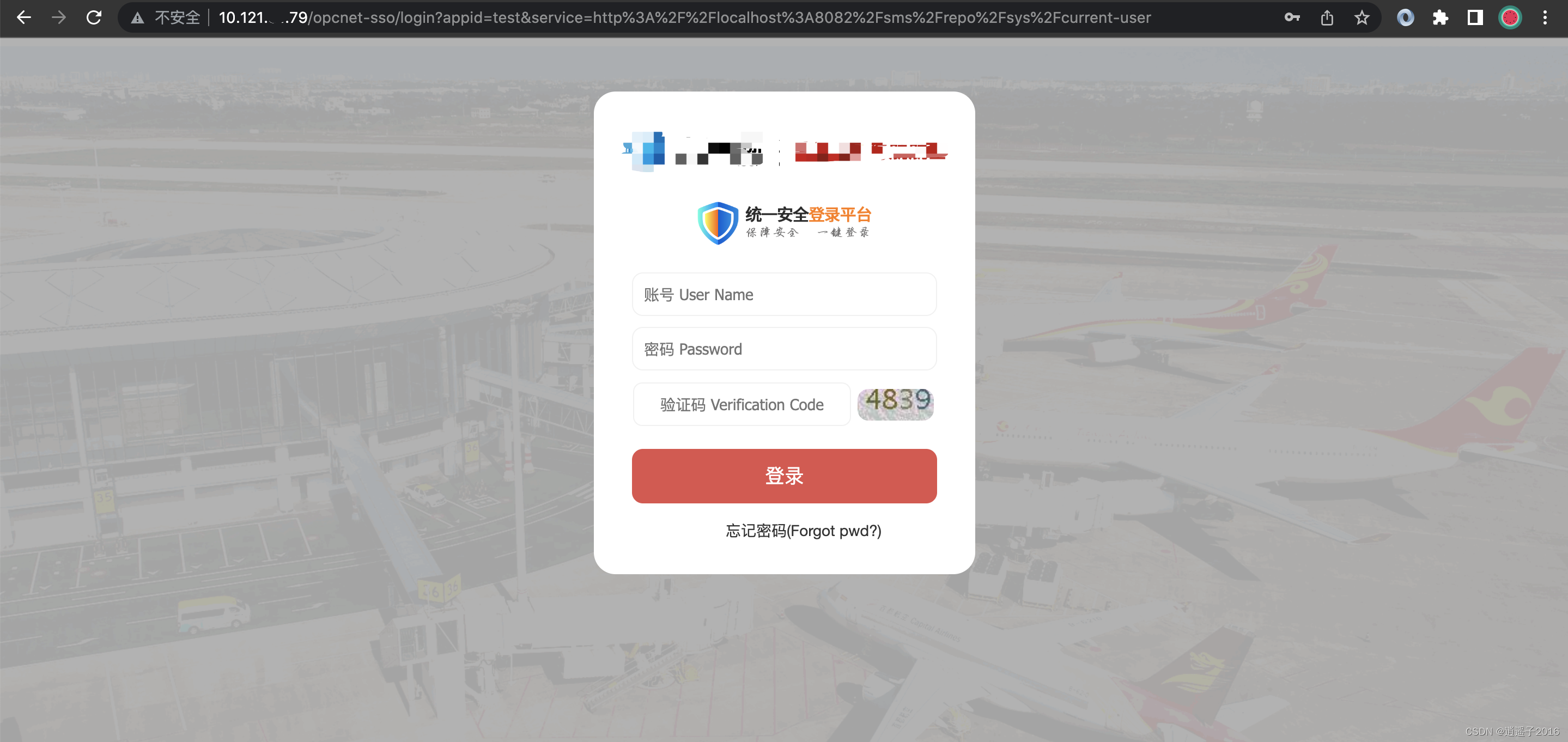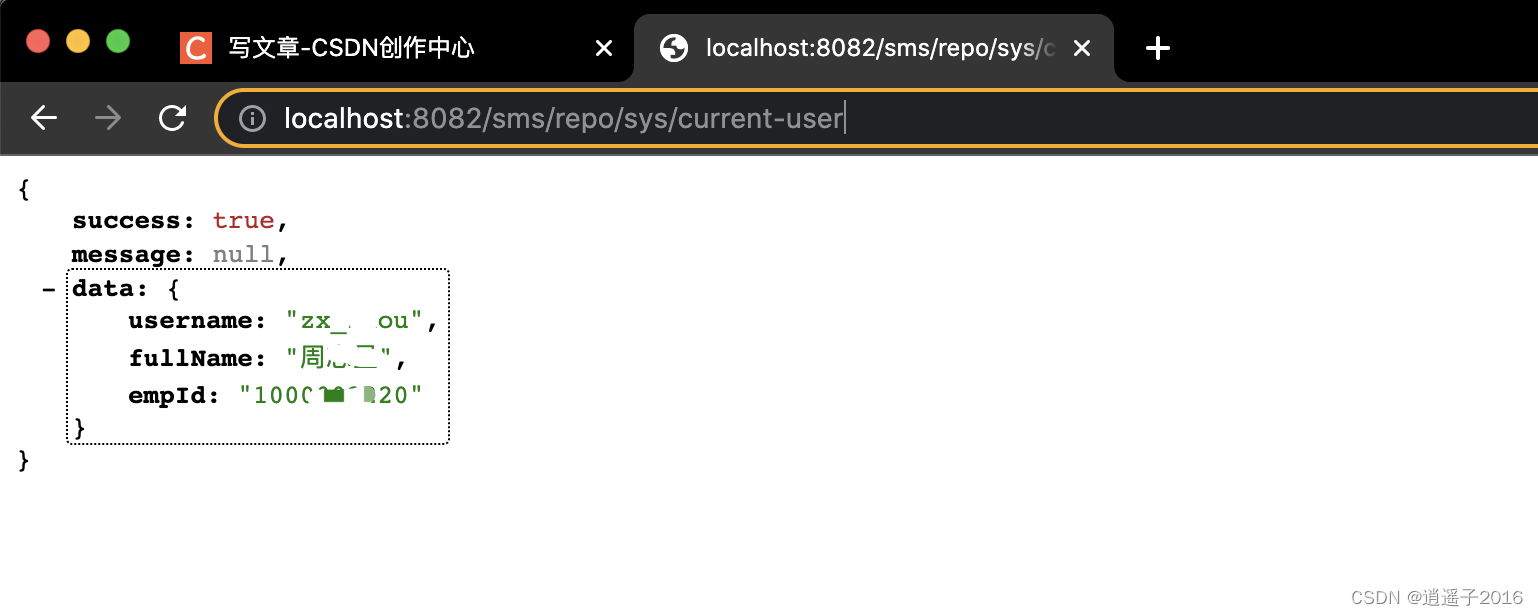CAS(Central Authentication Server)是Yelu大学研发单点登录解决方案。
它包含Server端和Client端,Server一般是每个公司部署一个,Client端则由各个系统自行引入。本文是Java项目,所以本文讨论的都是CAS的Java客户端。
CAS客户端主要做两件事,身份认证(默认通过AuthenticationFilter实现)和票据校验(默认通过Cas20ProxyReceivingTicketValidationFilter实现),基于javax.servlet.Filter。
本文建立在您已了解CAS流程的基础上,如果有不太了解的博友,可以先参考一下这篇博客,讲得很清楚:CAS单点登录原理(包含详细流程,讲得很透彻,耐心看下去一定能看明白!)
背景
现在新开发一个前后端分离系统,后端是SpringBoot(地址:localhost:8082),前端是Vue项目(地址:localhost:8081)。现要求该系统接入CAS Java客户端,实现单点登录
实现分析
CAS客户端基于Filter实现,默认支持的是前后端一体的系统,对于前后端分离的系统,需要对CAS做一些扩展才能正常使用。根本原因在于,前后端分离系统一般是通过ajax通信,而CAS依赖Servlet的重定向,但对于ajax的请求,浏览器是不会响应重定向的(原因会在附录分析)
但对于前后端一体的系统来说就不同了,用户访问系统时,浏览器是先向后端请求网页(html、jsp、thymelaef等),再由网页中的javascript向后端请求数据(jsp、thymelaef可能不需要)。对于浏览器发起的请求,是可以响应重定向的。所以在浏览器向后端请求网页时,Filter发现CAS未登录,就可以按默认逻辑重定向到CAS登录页面了
实现步骤
1.身份认证
引入依赖
<dependency>
<groupId>org.jasig.cas.client</groupId>
<artifactId>cas-client-support-springboot</artifactId>
<version>3.6.2</version>
</dependency>
application.yml中配置属性
cas:
server-login-url: http://10.121.xx.79/opcnet-sso/login?appid=test #CAS统一登录地址
validation-type: cas
server-url-prefix: http://10.121.xx.79/opcnet-sso #CAS服务端地址
client-host-url: http://localhost:${server.port} #本项目地址
实现自定义的重定向策略
创建一个类SmsAuthenticationRedirectStrategy,实现AuthenticationRedirectStrategy接口,重写redirect方法。默认实现是response.redirect()重定向到单点登录页面,这里修改默认实现,不再执行重定向,而是返回401状态码和错误信息
实现原理详见附录:原理分析1.CAS身份认证
@Slf4j
public class SmsAuthenticationRedirectStrategy implements AuthenticationRedirectStrategy {
@Override
public void redirect(HttpServletRequest request, HttpServletResponse response, String potentialRedirectUrl) throws IOException {
//设置401
response.setStatus(HttpStatus.UNAUTHORIZED.value());
//响应数据
Map<String, Object> data = ImmutableMap.<String, Object>builder()
.put("errorType", "NOT_LOGIN_CAS")
.put("casLoginUrl", potentialRedirectUrl)
.build();
//输出
PrintWriter out = response.getWriter();
out.println(JSON.toJSONString(data));
out.flush();
out.close();
}
}
应用自定义的重定向策略
新建一个类SmsCasClientConfigurer,实现CasClientConfigurer,重写configureAuthenticationFilter方法
实现原理详见附录:原理分析1.CAS身份认证
@Configuration
public class SmsCasClientConfigurer implements CasClientConfigurer {
@Override
public void configureAuthenticationFilter(FilterRegistrationBean authenticationFilter) {
authenticationFilter.addInitParameter("authenticationRedirectStrategyClass", "com.hnair.sms.repo.component.cas.SmsAuthenticationRedirectStrategy");
}
}
2.响应401
前端拦截401
前端发请求工具使用的是axios,响应拦截器配置如下
/**
* 1.200:
* success为true:请求成功
* success为false:请求失败,返回可读信息
*
* 2.401:
* errorType为NOT_LOGIN_CAS:CAS校验不通过,跳转到CAS登录界面
*
* 3.其他:(例如400,404,500,502,504等)
* 均显示为未知错误
*/
request.interceptors.response.use(
response => {
if (response.data.success) {
return Promise.resolve(response.data);
} else {
showMessage("请求失败,异常信息:" + response.data.message, "error")
return Promise.reject()
}
},
error => {
let status = error.response.status;
let data = error.response.data;
if (status === 401) {
if (data.errorType && data.errorType === "NOT_LOGIN_CAS") {
//发现CAS未登录,跳转到CAS统一登录页面
location.href = data.casLoginUrl
} else {
return Promise.reject(error)
}
} else {
showMessage("未知错误,请联系管理员", "error")
return Promise.reject(error)
}
}
)
3.票据检验
实现自定义的票据校验过滤器
新建一个类SmsCas20ProxyReceivingTicketValidationFilter,继承自Cas20ProxyReceivingTicketValidationFilter,重写onSuccessfulValidation方法。因为默认的票据校验过滤器在验证成功后,会重定向到源请求地址,这里修改为重定向到前端首页
实现原理详见附录:原理分析2.CAS票据检验
public class SmsCas20ProxyReceivingTicketValidationFilter extends Cas20ProxyReceivingTicketValidationFilter {
@SneakyThrows
@Override
protected void onSuccessfulValidation(HttpServletRequest request, HttpServletResponse response, Assertion assertion) {
//重定向到前端首页。此处为方便阅读使用了硬编码,实际应用时,应写入配置文件
response.sendRedirect("localhost:8081");
}
}
应用自定义的票据校验过滤器
回到第1步创建的类SmsCasClientConfigurer,新添加一个重写的configureValidationFilter方法,重新设置过滤器
实现细节详见附录:原理分析2.CAS票据检验
@Configuration
public class SmsCasClientConfigurer implements CasClientConfigurer {
@Override
public void configureAuthenticationFilter(FilterRegistrationBean authenticationFilter) {
authenticationFilter.addInitParameter("authenticationRedirectStrategyClass", "com.hnair.sms.repo.component.cas.SmsAuthenticationRedirectStrategy");
}
@Override
public void configureValidationFilter(FilterRegistrationBean validationFilter) {
validationFilter.setFilter(new SmsCas20ProxyReceivingTicketValidationFilter());
}
}
4.效果演示
分别启动前后端项目,访问前端首页,发起了一个ajax请求
注:由于前端使用了代理,所以network显示请求的域是localhost:8081,实际请求的域是localhost:8082

该请求被AuthenticationFilter拦截,并发现CAS未登录,准备跳转至登录页面,进入了SmsAuthenticationRedirectStrategy

前端收到401响应

进入ajax失败回调

location.href跳转至CAS登录页面。从地址栏可以注意到,源请求url作为查询参数赋值给了service,登录完成后,浏览器会回调service中的url

输入账号密码后,执行票据校验,校验成功后,进入SmsCas20ProxyReceivingTicketValidationFilter。接着,浏览器从CAS登录页面跳转到前端首页,CAS登录完成

附录:原理分析
1.CAS身份认证
关于ajax与重定向
前面已经提到,由于前后端交互使用的是ajax,对于ajax请求,浏览器不会响应重定向。下方示例为ajax处理重定向的场景。
可以看到响应状态码是302,后面紧跟了CAS登录请求的URL。正常来说此时浏览器应该要跳转了,但实际却不会,而且该ajax请求也并没有结束,它仍在请求重定向后的url,请求成功后,进入ajax成功回调,这时ajax才完成。
从下方第二个截图可以看出,源请求接收到是重定向后url的响应,状态码为200,响应数据为CAS登录页面的html文本。
对于ajax这样处理的原因,感兴趣的博友可以参考一下这篇文章:ajax 遇到重定向,ajax 重定向跨域问题


使用401响应来代替重定向
后端重定向行不通,可以返回别的响应码,比如401、500或者200,然后让前端来控制浏览器跳转。本例中选择了401响应
下面是AuthenticationFilter类的doFilter方法,主要逻辑是当发现CAS未登录时,就调用this.authenticationRedirectStrategy.redirect重定向到CAS登录页面(为方便阅读,只保留了与本文相关的代码)
public class AuthenticationFilter extends AbstractCasFilter {
/**
* 默认的重定向策略,详见下方DefaultAuthenticationRedirectStrategy源码
*/
private AuthenticationRedirectStrategy authenticationRedirectStrategy = new DefaultAuthenticationRedirectStrategy();
@Override
public final void doFilter(final ServletRequest servletRequest, final ServletResponse servletResponse,
final FilterChain filterChain) throws IOException, ServletException {
final HttpServletRequest request = (HttpServletRequest) servletRequest;
final HttpServletResponse response = (HttpServletResponse) servletResponse;
final HttpSession session = request.getSession(false);
final Assertion assertion = session != null ? (Assertion) session.getAttribute(CONST_CAS_ASSERTION) : null;
//CAS已登录的判断条件是:session存在且包含用户信息
if (assertion != null) {
filterChain.doFilter(request, response);
return;
}
//生成重定向的URL
final String urlToRedirectTo = CommonUtils.constructRedirectUrl(this.casServerLoginUrl,
getProtocol().getServiceParameterName(), constructServiceUrl(request, response);, this.renew, this.gateway, this.method);
//重定向到CAS登录页面
this.authenticationRedirectStrategy.redirect(request, response, urlToRedirectTo);
}
//其余代码省略...
}
this.authenticationRedirectStrategy采用了策略模式,默认策略为DefaultAuthenticationRedirectStrategy,源码如下
public final class DefaultAuthenticationRedirectStrategy implements AuthenticationRedirectStrategy {
@Override
public void redirect(final HttpServletRequest request, final HttpServletResponse response,
final String potentialRedirectUrl) throws IOException {
response.sendRedirect(potentialRedirectUrl);
}
}
如何修改这个默认策略呢?
查看AuthenticationFilter的初始化方法,这里设置了this.authenticationRedirectStrategy(为方便阅读,只保留了与本文相关的代码)
public class AuthenticationFilter extends AbstractCasFilter {
@Override
protected void initInternal(final FilterConfig filterConfig) throws ServletException {
if (!isIgnoreInitConfiguration()) {
super.initInternal(filterConfig);
//从用户给定的authenticationRedirectStrategyClass参数中获取类的全限定名并获取其Class对象,然后通过反射创建实例
final Class<? extends AuthenticationRedirectStrategy> authenticationRedirectStrategyClass = getClass(ConfigurationKeys.AUTHENTICATION_REDIRECT_STRATEGY_CLASS);
if (authenticationRedirectStrategyClass != null) {
this.authenticationRedirectStrategy = ReflectUtils.newInstance(authenticationRedirectStrategyClass);
}
}
}
}
所以说,我们需要给AuthenticationFilter设置authenticationRedirectStrategyClass参数,参数值就是【实现步骤 - 1.身份认证 - 实现自定义的重定向策略】中创建的类SmsAuthenticationRedirectStrategy的全限定名
如何设置这个值呢?
一般来说,SpringMVC项目引入CAS客户端,通常是在web.xml中配置相关过滤器。而SpringBoot项目由于其自动配置的特性,整合到SpringBoot的三方库一般会提供自动配置类。
cas-client-support-springboot也提供了一个自动配置类:org.jasig.cas.client.boot.configuration.CasClientConfiguration,该类配置了CAS流程所需要的所有过滤器,下面是注册AuthenticationFilter的代码。它使用FilterRegistrationBean注册过滤器(相当于在web.xml中配置<filter>)
注意最后面几行代码,它支持用this.casClientConfigurer进行自定义修改
@Configuration
@EnableConfigurationProperties(CasClientConfigurationProperties.class)
public class CasClientConfiguration {
@Bean
public FilterRegistrationBean casAuthenticationFilter() {
//通过FilterRegistrationBean注册一个过滤器
final FilterRegistrationBean authnFilter = new FilterRegistrationBean();
//application.yml中validation-type: cas,所以执行的是new AuthenticationFilter()
final Filter targetCasAuthnFilter =
this.configProps.getValidationType() == EnableCasClient.ValidationType.CAS
|| configProps.getValidationType() == EnableCasClient.ValidationType.CAS3
? new AuthenticationFilter()
: new Saml11AuthenticationFilter();
initFilter(authnFilter,
targetCasAuthnFilter,
2,
constructInitParams("casServerLoginUrl", this.configProps.getServerLoginUrl(), this.configProps.getClientHostUrl()),
this.configProps.getAuthenticationUrlPatterns());
//支持自定义配置AuthenticationFilter过滤器
if (this.casClientConfigurer != null) {
this.casClientConfigurer.configureAuthenticationFilter(authnFilter);
}
return authnFilter;
}
//其余代码省略...
}
casClientConfigurer是一个接口,源码如下:
public interface CasClientConfigurer {
default void configureAuthenticationFilter(FilterRegistrationBean authenticationFilter) {
}
default void configureValidationFilter(FilterRegistrationBean validationFilter) {
}
default void configureHttpServletRequestWrapperFilter(FilterRegistrationBean httpServletRequestWrapperFilter) {
}
default void configureAssertionThreadLocalFilter(FilterRegistrationBean assertionThreadLocalFilter) {
}
}
下面是casClientConfigurer初始化的代码,可以看出,它通过@autowired注入依赖。所以就有了【实现步骤 - 1.身份认证 - 应用自定义的重定向策略】,重写configureAuthenticationFilter方法后,就可以给AuthenticationFilter设置authenticationRedirectStrategyClass参数了
@Configuration
@EnableConfigurationProperties(CasClientConfigurationProperties.class)
public class CasClientConfiguration {
private CasClientConfigurer casClientConfigurer;
@Autowired(required = false)
void setConfigurers(final Collection<CasClientConfigurer> configurers) {
if (CollectionUtils.isEmpty(configurers)) {
return;
}
if (configurers.size() > 1) {
throw new IllegalStateException(configurers.size() + " implementations of " +
"CasClientConfigurer were found when only 1 was expected. " +
"Refactor the configuration such that CasClientConfigurer is " +
"implemented only once or not at all.");
}
this.casClientConfigurer = configurers.iterator().next();
}
}
2.CAS票据检验
重定向到CAS登录页面后,用户需要输入账号密码登录,前面说到,登录成功后,浏览器会跳转到service参数指定的url,且会在该url后面追加一个参数ticket,即CAS-Server签发的票据。另外从前面的中截图可以看到service的参数值(解码后为:http://localhost:8082/sms/repo/sys/current-user,也就是第1步身份认证时被AuthenticationFilter拦截的url)

刚才说到,登录成功后,浏览器会跳转到http://localhost:8082/sms/repo/sys/current-user。那登录成功后,页面将会是这样的

很明显这不是预期的效果,我们希望登录成功后浏览器跳转到前端的首页,如何实现呢?
下面是注册票据校验过滤器的代码,可以看到使用的是Cas20ProxyReceivingTicketValidationFilter,它的执行顺序为1(AuthenticationFilter的执行顺序为2),意味的请求会先进入Cas20ProxyReceivingTicketValidationFilter的doFilter方法
@Configuration
@EnableConfigurationProperties(CasClientConfigurationProperties.class)
public class CasClientConfiguration {
@Bean
@ConditionalOnProperty(prefix = "cas", name = "skipTicketValidation", havingValue = "false", matchIfMissing = true)
public FilterRegistrationBean casValidationFilter() {
final FilterRegistrationBean validationFilter = new FilterRegistrationBean();
final Filter targetCasValidationFilter;
switch (this.configProps.getValidationType()) {
//根据由application.yml中的配置,进入case CAS分支
case CAS:
targetCasValidationFilter = new Cas20ProxyReceivingTicketValidationFilter();
break;
case SAML:
targetCasValidationFilter = new Saml11TicketValidationFilter();
break;
case CAS3:
default:
targetCasValidationFilter = new Cas30ProxyReceivingTicketValidationFilter();
break;
}
initFilter(validationFilter,
targetCasValidationFilter,
1,
constructInitParams("casServerUrlPrefix", this.configProps.getServerUrlPrefix(), this.configProps.getClientHostUrl()),
this.configProps.getValidationUrlPatterns());
if (this.casClientConfigurer != null) {
this.casClientConfigurer.configureValidationFilter(validationFilter);
}
return validationFilter;
}
//其余代码省略...
}
查看Cas20ProxyReceivingTicketValidationFilter源码可知,它自身并没有实现doFilter方法,doFilter方法在它的父类中实现
public class Cas20ProxyReceivingTicketValidationFilter extends AbstractTicketValidationFilter {
}
AbstractTicketValidationFilter的doFilter方法(为方便阅读,只保留了与本文相关的代码)
public abstract class AbstractTicketValidationFilter extends AbstractCasFilter {
@Override
public final void doFilter(final ServletRequest servletRequest, final ServletResponse servletResponse,
final FilterChain filterChain) throws IOException, ServletException {
final HttpServletRequest request = (HttpServletRequest) servletRequest;
final HttpServletResponse response = (HttpServletResponse) servletResponse;
//从请求参数中获取ticket
final String ticket = retrieveTicketFromRequest(request);
//ticket存在,才执行票据校验逻辑,否则跳过该过滤器
if (CommonUtils.isNotBlank(ticket)) {
try {
//票据校验,返回包含当前登录用户的信息
final Assertion assertion = this.ticketValidator.validate(ticket,
constructServiceUrl(request, response));
//this.useSession默认值为true,用户信息将被存入session
if (this.useSession) {
request.getSession().setAttribute(CONST_CAS_ASSERTION, assertion);
}
//校验成功回调,预留给子类实现
onSuccessfulValidation(request, response, assertion);
//this.redirectAfterValidation默认为true,校验完成后,会重定向到request.getRequestUrl(),在本例中,就是:http://localhost:8082/sms/repo/sys/current-user
if (this.redirectAfterValidation) {
response.sendRedirect(constructServiceUrl(request, response));
return;
}
}
}
filterChain.doFilter(request, response);
}
protected void onSuccessfulValidation(final HttpServletRequest request, final HttpServletResponse response,
final Assertion assertion) {
// nothing to do here.
}
}
看到这里,浏览器没有出现预期效果的原因也就清晰了,doFilter方法在校验成功后,默认重定向到request.getRequestUrl(),我们要修改这个重定向url
所以就有了前面【实现步骤 - 3.票据检验】,新建了一个类SmsCas20ProxyReceivingTicketValidationFilter继承自Cas20ProxyReceivingTicketValidationFilter,重写onSuccessfulValidation方法,重定向到前端首页就可以了。
版权归原作者 逍遥子2016 所有, 如有侵权,请联系我们删除。